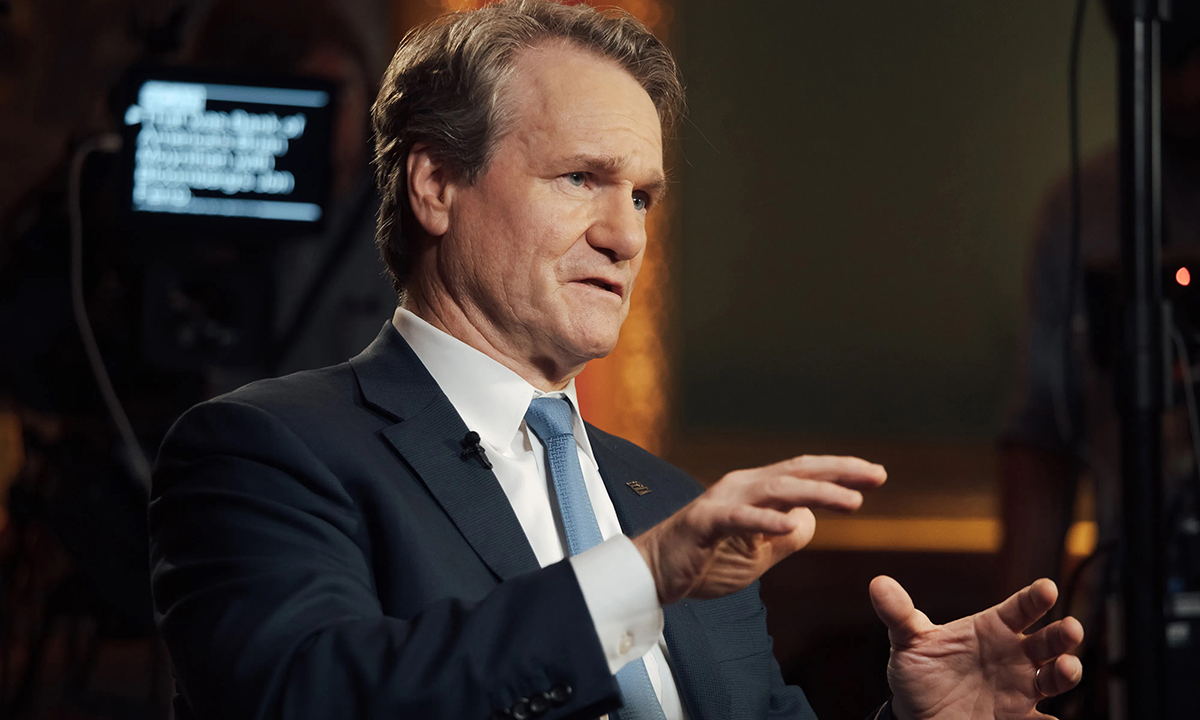
美銀CEO布萊恩·莫伊尼漢近日對美國國債發出警告,雖然很多人對他的言論置若罔聞,但這并不影響他堅持發出自己的聲音。
目前,美國國債水平已經超過了35.7萬億美元大關,攤到每個美國人身上,就是人均負債超10.5萬美元。
和華爾街大亨杰米·戴蒙、美聯儲主席杰羅姆·鮑威爾等人一樣,莫伊尼漢也在大聲疾呼,美國應把降債當作頭等大事,想方設法將美國國債與GDP的比重恢復到正常水平。
但是對于莫伊尼漢來說,可惜的是誰,下步無論是誰入主白宮,可能都不大會聽從他的警告。
下一步無論是哈里斯上臺,還是特朗普二次當政,都只會讓美國的公共債務水平再增加數萬億美元。
莫伊尼漢認為,如果美國不能在支出和增長之間取得平衡,總有一天會被事實教做人。如果這個問題一直得不到解決,美元遲早會失去“金本位”地位。
莫伊尼漢對《福克斯新聞》表示:“如果你回顧過去的10年、12年,人們一直在擔心債務問題失控。”
“然后疫情爆發了,政府需要大量支出來打贏防疫戰,還要防止經濟惡化,陷入嚴重衰退。”
“在這方面,上一屆和這一屆美國政府做得很好。但是現在,就像每次戰爭結束之后一樣,我們都有一個不得不回答的問題:‘錢誰來付?’”
根據聯邦預算問責委員會的數據,在特朗普的任期內,美國國債水平凈增長8.4萬億美元。其中,4.8萬億美元是與疫情無關的債務,另3.6萬億美元主要來自與疫情有關的《關懷法案》和紓困計劃。
拜登上臺以來,美國國債凈增長4.3萬億,其中2.2萬億美元與疫情無關,2.1萬億美元用于“美國救助計劃”。
美國怎樣才能實現債務水平再平衡?
經濟學家并不擔心美國政府債務問題。他們甚至認為,政府舉債,對于維持住美國至關重要的債券市場是十分必要的。
他們真正擔心的是美國的債務與GDP之間的比例。
如果這一比率失衡了,就表明美國經濟的增長水平不足以償還現有債務,美國也就不應該進一步舉債,來滿足未來財政政策的需要。
據美國國會預算辦公室今年3月份的一份報告估算,到2054年,美國的公共債務水平將達到達到141.1萬億美元,相當于GDP的166%。
莫伊尼漢表示,美國必須做出一些艱難的決定。“這需要方方面面都遵守嚴格的紀律……這方面的建議一直都是有的,但是這次我們必須真的著手去做了。”
莫伊尼漢補充道:“我們不需要采取任何重大的改革。我們只需要養成這種習慣:‘你看,今天我們花出去的又比收入多了。’ 我們必須縮小這個差距。”
“我們在國防、社會服務項目、基建等領域都要共花錢,我們有各種各樣的事要做,但是歸根到底,我們要努力促進收支平衡。“
要想讓債務與GDP之比回歸健康水平,政策制定者們面前有兩個選項,一是削減支出,二是增加GDP。
“你可以用不同方式實現這個目標,可以通過經濟增長,也可以通過控制開支,或者降低水平來促進投資水平。但我可以告訴你,全世界現在都在羨慕美國經濟,但是如果我們管理不好債務問題,以后他們就不會這么羨慕了。”莫伊尼汗說。
何時動手解決問題
有些專家認為,美國的國債目前不會構成問題,因為最近的國債支出都是著眼于提升生產率的。
哥倫比亞大學教授布雷特·豪斯今年4月接受《財富》采訪時表示:“如果公共債務被投資到了提高生產率上,以確保經濟增長水平與債務融資水平相符,那這筆債務就是合理債務。”
他還表示,雖然對于大多數國家來說,債務與GDP之比超過100%都是一個問題,但是“美國不是大多數國家。”
豪斯教授表示:“美國發行的所有債務都是美元,所以我們會發現,當全球發生政治或金融危機時,資金就會流向美國國債和債券市場,因為它是一種安全保值的手段。由于美國發行的所有債務都是美元,所以它的債務總能找到其他買家。”
當然也有許多專家不同意這種看法,并表示市場總有一天會質疑美國是否有能力償還這些債務。
莫伊尼漢認為,如果不加以控制,美債終將成為一個大問題,但他也認為,這個問題不是短期內就能解決的。“這不是新政府上任就能馬上解決的問題,也不是現政府連任就能馬上解決的問題——這是一個需要長時間遵守財政紀律才能解決的問題。”(財富中文網)
譯者:樸成奎
美銀CEO布萊恩·莫伊尼漢近日對美國國債發出警告,雖然很多人對他的言論置若罔聞,但這并不影響他堅持發出自己的聲音。
目前,美國國債水平已經超過了35.7萬億美元大關,攤到每個美國人身上,就是人均負債超10.5萬美元。
和華爾街大亨杰米·戴蒙、美聯儲主席杰羅姆·鮑威爾等人一樣,莫伊尼漢也在大聲疾呼,美國應把降債當作頭等大事,想方設法將美國國債與GDP的比重恢復到正常水平。
但是對于莫伊尼漢來說,可惜的是誰,下步無論是誰入主白宮,可能都不大會聽從他的警告。
下一步無論是哈里斯上臺,還是特朗普二次當政,都只會讓美國的公共債務水平再增加數萬億美元。
莫伊尼漢認為,如果美國不能在支出和增長之間取得平衡,總有一天會被事實教做人。如果這個問題一直得不到解決,美元遲早會失去“金本位”地位。
莫伊尼漢對《福克斯新聞》表示:“如果你回顧過去的10年、12年,人們一直在擔心債務問題失控。”
“然后疫情爆發了,政府需要大量支出來打贏防疫戰,還要防止經濟惡化,陷入嚴重衰退。”
“在這方面,上一屆和這一屆美國政府做得很好。但是現在,就像每次戰爭結束之后一樣,我們都有一個不得不回答的問題:‘錢誰來付?’”
根據聯邦預算問責委員會的數據,在特朗普的任期內,美國國債水平凈增長8.4萬億美元。其中,4.8萬億美元是與疫情無關的債務,另3.6萬億美元主要來自與疫情有關的《關懷法案》和紓困計劃。
拜登上臺以來,美國國債凈增長4.3萬億,其中2.2萬億美元與疫情無關,2.1萬億美元用于“美國救助計劃”。
美國怎樣才能實現債務水平再平衡?
經濟學家并不擔心美國政府債務問題。他們甚至認為,政府舉債,對于維持住美國至關重要的債券市場是十分必要的。
他們真正擔心的是美國的債務與GDP之間的比例。
如果這一比率失衡了,就表明美國經濟的增長水平不足以償還現有債務,美國也就不應該進一步舉債,來滿足未來財政政策的需要。
據美國國會預算辦公室今年3月份的一份報告估算,到2054年,美國的公共債務水平將達到達到141.1萬億美元,相當于GDP的166%。
莫伊尼漢表示,美國必須做出一些艱難的決定。“這需要方方面面都遵守嚴格的紀律……這方面的建議一直都是有的,但是這次我們必須真的著手去做了。”
莫伊尼漢補充道:“我們不需要采取任何重大的改革。我們只需要養成這種習慣:‘你看,今天我們花出去的又比收入多了。’ 我們必須縮小這個差距。”
“我們在國防、社會服務項目、基建等領域都要共花錢,我們有各種各樣的事要做,但是歸根到底,我們要努力促進收支平衡。“
要想讓債務與GDP之比回歸健康水平,政策制定者們面前有兩個選項,一是削減支出,二是增加GDP。
“你可以用不同方式實現這個目標,可以通過經濟增長,也可以通過控制開支,或者降低水平來促進投資水平。但我可以告訴你,全世界現在都在羨慕美國經濟,但是如果我們管理不好債務問題,以后他們就不會這么羨慕了。”莫伊尼汗說。
何時動手解決問題
有些專家認為,美國的國債目前不會構成問題,因為最近的國債支出都是著眼于提升生產率的。
哥倫比亞大學教授布雷特·豪斯今年4月接受《財富》采訪時表示:“如果公共債務被投資到了提高生產率上,以確保經濟增長水平與債務融資水平相符,那這筆債務就是合理債務。”
他還表示,雖然對于大多數國家來說,債務與GDP之比超過100%都是一個問題,但是“美國不是大多數國家。”
豪斯教授表示:“美國發行的所有債務都是美元,所以我們會發現,當全球發生政治或金融危機時,資金就會流向美國國債和債券市場,因為它是一種安全保值的手段。由于美國發行的所有債務都是美元,所以它的債務總能找到其他買家。”
當然也有許多專家不同意這種看法,并表示市場總有一天會質疑美國是否有能力償還這些債務。
莫伊尼漢認為,如果不加以控制,美債終將成為一個大問題,但他也認為,這個問題不是短期內就能解決的。“這不是新政府上任就能馬上解決的問題,也不是現政府連任就能馬上解決的問題——這是一個需要長時間遵守財政紀律才能解決的問題。”(財富中文網)
譯者:樸成奎
Brian Moynihan’s warnings over the national debt may be falling on deaf ears, but that isn’t going to stop the Bank of America CEO from sounding the alarm.
Uncle Sam’s national debt has tipped over the $35.7 trillion mark, meaning the burden for each person in America is now more than $105,000.
Moynihan, like his Wall Street peer Jamie Dimon and Fed Chairman Jerome Powell, is pushing politicians to prioritize plans for bringing the country’s debt-to-GDP back into line.
Unfortunately for Moynihan, the potential new incumbents to the White House are paying little heed to their warnings.
In fact, plans under both Donald Trump and Kamala Harris would increase America’s public debt by trillions.
Moynihan believes America is headed for a rude awakening if it doesn’t balance its spending with its growth. If the problem isn’t addressed, America could lose its place as the economic “gold standard.”
“If you go back the last 10, 12 years, there’s been a constant worry about the debt getting too far ahead,” Moynihan told Fox News.
“Then we had COVID, which required a lot of money being spent by the government to win the war on the virus and keep the economy from going really south and really having a deep recession.
“The government—the prior administration and the current administration—all did a good job. That’s gone now. Now we’ve gotta say, like every war you’ve fought: ‘How do you pay the bills after?’”
According to the Committee for a Responsible Federal Budget, the net increase in debt under President Donald Trump was $8.4 trillion: $4.8 trillion in non-COVID-related borrowing and $3.6 trillion for the CARES Act and COVID relief.
President Joe Biden increased national debt by $4.3 trillion: $2.2 trillion in non-COVID borrowing and $2.1 trillion for the American Rescue Plan.
How does the U.S. rebalance its debt?
Economists aren’t worried about the American government borrowing; in fact, it’s necessary to maintain the nation’s crucial bond market.
What they are worried about is the country’s debt-to-GDP ratio.
If this ratio is out of balance, it signals that the U.S. economy is not generating enough growth to service existing debt or take out more loans needed for fiscal policies in the future.
A March report from the Congressional Budget Office (CBO) estimates that by 2054, public debt will represent 166% of GDP, reaching $141.1 trillion.
Moynihan said some tough decisions lie ahead: “It’s going to take a combination of extreme discipline on all sides … There have always been proposals, but it’s time we have to do it.
“It doesn’t take a massive move one way or the other way,” Moynihan added. “It just takes a ‘Look, at the end of the day we spend more money than we bring in. We gotta narrow that gap.’
“Yet we’ve got to spend on defense, we’ve got to spend on social services programs, we got to invest in infrastructure. There’s all kinds of things that have got to go on, but at the end of the day, you’ve got to start to get your eyes and stomach aligned.”
To bring the debt-GDP balance into line, policymakers have two options: cutting spending or increasing GDP.
“You can do it different ways. You can do it through growth, you could do it through expense discipline, you can do it through raising taxes, you can do it through lowering taxes to create more investment,” Moynihan added. “But I’m telling you, around the world, this economy is the envy of everyone, and if we don’t manage the debt well, it may not be so envious in the future.”
When to tackle the problem
Some experts believe that America’s national debt doesn’t pose a problem because recent spending has been aimed at increasing productivity.
“Public debt is justified if it is invested in productivity-enhancing measures that will ensure the economy generates growth that’s required to finance that debt,” Columbia University professor Brett House told Fortune in April.
He added that while a debt-to-GDP ratio of over 100% would be a problem for most countries, “the United States is not most countries.”
Professor House added America “issues all of its debt in U.S. dollars, and consistently, when we see the world in political or financial crisis, money flows into U.S. Treasuries and the bond market as a safe store of value. Because the U.S. issues all of its debt in U.S. dollars it always has the possibility of finding additional buyers for its debt.”
A host of experts disagree with this take, saying the market will one day question whether America can pay its debt.
Moynihan clearly believes Uncle Sam’s debt will become a problem if left unchecked, but didn’t set the countdown in the short term: “It’s not an issue to handle in the first week of a new administration or an old administration continuing—it’s the question of having the discipline across time.”






